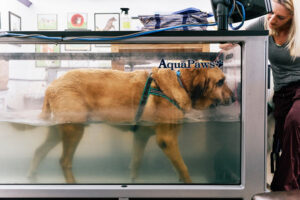Many animals can benefit from the services of physical rehabilitation. In the human world of health care, we receive physical rehabilitation after an injury or surgery, for any type of pain or dysfunction. We also receive treatment after neurological injuries (such as a stroke), for fractures, sprains or strains, for the treatment of wounds, athletic injuries, arthritic conditions (Lyme Disease) and the effects of aging (osteoarthritis).
Animals can receive physical rehabilitation for all of the above. Too often, our pets do not receive physical rehabilitation and this may prevent them from returning to a full recovery.
Some of the diagnoses commonly treated with physical rehabilitation:
- Hip Dysplasia
- Elbow Dysplasia
- Spinal conditions
- Post surgical conditions – orthopedic and neurological
- ACL or CCL injuries
- Muscle Strains/Pulls
- Arthritis
- Degenerative Myelopathy
- Athletic Injuries
- Sore joints
- Fibrocartilagenous Emboli
- Post fracture management
- Trauma
- Disc conditions
And many more – please contact us with any questions on your dog’s condition


